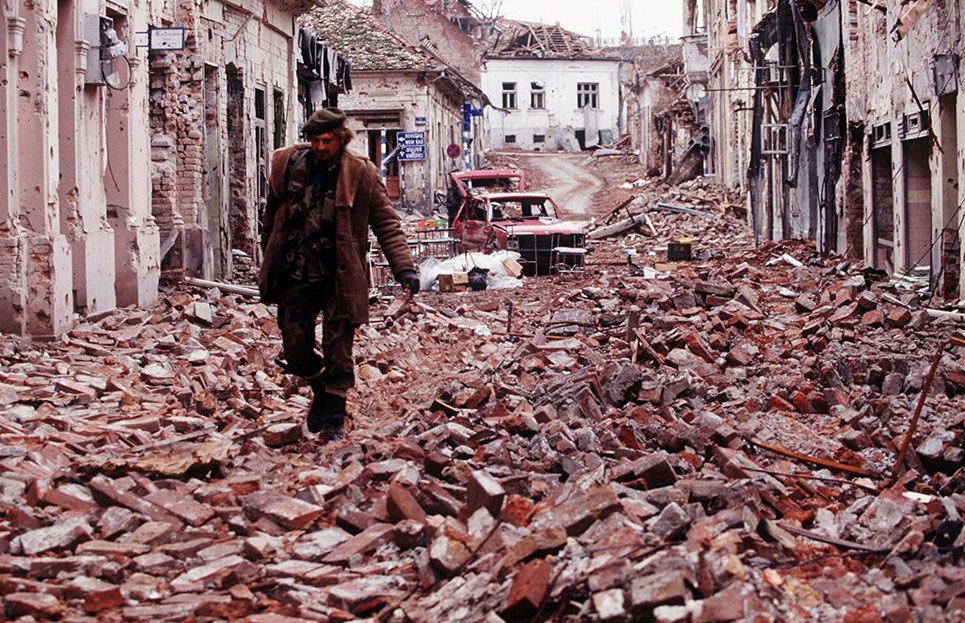 Croatia is one step away from independence. In the first democratic elections, which took place in April 1990 r., the victory was won by the Croatian Democratic Community headed by Franjo Tudjman. At the inaugural session of the new Croatian parliament in May 1990 r. it was decided, among others. abolish all socialist symbols and replace them with national ones – Croatian. It happened then (already in July 1990 r.) to local Serb revolts (in the number of approx. 600 thousand) living in the republic.
Croatia is one step away from independence. In the first democratic elections, which took place in April 1990 r., the victory was won by the Croatian Democratic Community headed by Franjo Tudjman. At the inaugural session of the new Croatian parliament in May 1990 r. it was decided, among others. abolish all socialist symbols and replace them with national ones – Croatian. It happened then (already in July 1990 r.) to local Serb revolts (in the number of approx. 600 thousand) living in the republic.
22 of December 1990 r. a new constitution was adopted. Serbs were treated as a minority in it, which provoked their opposition. 12 May in a referendum among the Serbs of northwestern Croatia 90% voters voted for the incorporation of these territories into Serbia and for integrity with Yugoslavia. The situation became more and more tense.
The first fights between Serbs and Croats broke out in May in Borovo Selo near Vukovar. 19 May in a referendum (boycotted by the Serbs) it opted for the creation of an independent state 94% voters (by 60% attendance).
25 house 1991 r. Slovenia and Croatia declared independence. At the same time, the Serbs from Krajina announced their autonomy and accession to Serbia. In December this year, they proclaimed the self-proclaimed Republika Srpska Krajina with its capital in Knin, which, however, has never been recognized by the international community. 26 In May, the government of Yugoslavia treated the independence decisions of Slovenia and Croatia as illegal, as a result, the troops of the Yugoslav People's Army attacked Slovenia, then Croatia.
Homeland war, that is, the war in defense of the homeland. In July 1991 r. Yugoslav People's Army, mainly composed of Serbs, and assisted by troops of Chetniks, launched a brutal aggression against Croatia. Although Croatia has agreed to suspend the declaration of independence for a period of three months, this did not prevent a cruel war.
Many towns and villages were destroyed or burned down. Next to the cities, which suffered the most, such as: Osijek, Słayonski Brod, Vinkovci, Helmet, Sibenik, Dubrovnik, Vukovar suffered the greatest damage. During the siege of this city, running from August to November 1991 r., Terrible crimes have been committed - so far, the mass graves of the brutally murdered have been discovered. During the fighting in Croatia, approx. 10 thousand. people, and hundreds of Croats, fearing terror, had to leave their homes.
In October 1991 r. The Croatian capital, Zagreb, was attacked. The offensive on the beautiful historic city of Dubrovnik was not backed off either.
According to the agreement signed in Sarajevo with 2 January 1992 r., Croatia and representatives of other former Yugoslav republics agreed to accept the plan of the European Community envoy, Cyrus Vance. In the middle of that year, hostilities in Croatia ceased for a while, and soldiers of the UN peacekeeping forces came to the country. Part of the lands (e.g.. areas of western and eastern Slavonia and Krajina) it was still in the hands of Croatian Serbs, who all the time sought to connect with Serbia.
In January 1993 r. Croatian forces liberated Novsko Zdrilo, areas around Zadar and the dam in Perućac. In May 1995 r. thanks to the action of the Croatian army, areas of western Slavonia returned to the country, and several thousand people of Serbian nationality left these areas. At that time, the Serbs attacked Zagreb for the second time (several people died, and many were wounded). In August 1995 r. after a short, but an effective operation called the Croatian Oluja (Storm), also Krajina and Knin returned to Croatia. It escaped from there then over 150 thousand. Serbs. The hostilities ceased only in 1995 r.
In the summer 1998 r. thanks to international peace intervention, and especially by the two-year efforts of the American J.. Klein, eastern Slavonia, Baranja and western Srijem have been peacefully controlled by the Croatian government and police.
The war in Croatia caused enormous material damage, however, it was the people who suffered the most – they lost their loved ones, many are still missing, and numerous Croatian refugees still wander the world.
Croatia was recognized by Germany back in December 1991 r., then 13 January 1992 r. by the Holy See, 15 January by the countries of the European Community, a 7 April by the US. The country became a part of the United Nations 22 house 1992 r.
During the first elections in an independent homeland, the Croatian Democratic Community won the absolute majority in parliament (HDZ), and Franjo Tudjman was elected president, who performed this function until the death of v 2000 r. His successor, Social Democrat Stjepan Mesic, 29 June 2000 r. paid a visit to the Senate of the Republic of Poland. He came to Poland on another official visit in September 2004 r.
The first years of the new century were rather successful for the Croats. Economic growth has achieved 5%, however, the government of Prime Minister Ivica Raczan appointed by Mesic was accused, that the changes come at too great a social cost.
In June 2004 r. The Council of Europe announced the launch of 2005 r. negotiations on Croatia's accession to the Union.